|
Documentation
glangsto -at- nrao.edu created on: 2003SEP23 |
Test of a deep integration observation using the Green Bank Telescope
and Prime Focus 1 receiver. A deep (2 hour) integration in the spectral band
795 to 845 MHz is presented to determine the RFIs level expected for sensitive
searchs.
A summary of RFI in the entire band was made on
February 22, 2003.
See below for a description of the observing setup. These spectra are calibrated using an estimated for the system temperature, since no reference noise diode signal was injected. The system temperature spectrum was computed using a 14 channel median filter for each of the two average polarization spectra obtained. The intensity scale was set by multiplying by the effective system temperature (30K) and dividing by the system temperature spectrum. Note that this process removes any spectral features wider than the 14 channel median width (features wider than 85 kHz, corresponding to 30 km/sec velocity). Also sensitivity is reduced for spectral features within 14 channels of the brightest features. The plot below shows a dual polarization observation of 3C286 in the frequency range 745 to 865 MHz. The high noise at the band edges is due to the attenuation of the band pass filter. The features at 796.53 and 817.77 MHz are due to features in the feed structure, not RFI.

The plots below show 1) the raw band pass shape, 2) calibrated band pass shape and 3) a selection of RFI features. Note that weak narrow features are moste easily seen by this data reduction technique. The estimated RMS in the two hour integration is 2 mK. For observation of a 1 Jy source (approx 2 K brightness temp), absorption features as weak as 1 % could be detected (10 sigma). Caution should be used, when applying the median filtering technique produces features at the extream of the band pass gain (ie at minima or maxima of the gain). At these spectral locations, features as bright as +/- 20 mK are seen, corresponding to 1 % features in a 1 Jy source. Note since the gain functions are different for the two polarizations, band pass features do not match in the two polarizations. |
RFI TableThe table below summarizes the strongest sources of RFI in the frequency range 750 to 900 MHz. The table also lists the redshift of neutral hydrogen corresponding to this RFI frequency. Higher resolution measurements of fainter features are presented for the 795 to 845 MHz band. The redshifts are calculated for the Delta_Frequency/Frequency convention.The frequency range 807.25 to 885.25 MHz was assigned to TV channels 70 to 83, but is now assigned to land mobile communications (ie portable phones, etc). |
|
||||||||||||||||||||||||||||||||||||||||||||||||||||||||||||||||||||||||||||||||||||||||||||||||||||||||||||||||||||||||||||||||||||||||||||||||||||||||||||||||||||||||||||||||||||||||||||||
|
Plot of the raw spectrum obtained towards a pulsar at low galactic latitude.
The band pass shape is primarily due to the combined effect of a
number of band pass filters in the IF chain.
The central "peak" is due to a resonance in the Feed structure, that reduces the system gain and increases the effective system temperature. A few RFI features are also clearly seen, indicating that these features have a spectral intensity comperable to the system temperature, 30 K. |
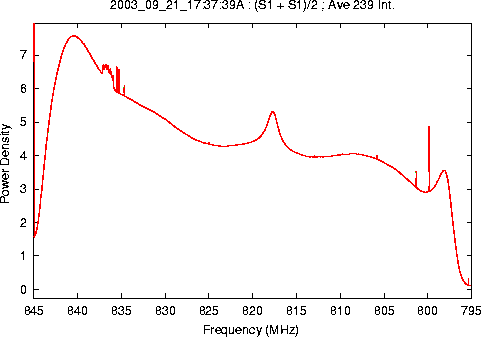
|
||||||||||||||||||||||||||||||||||||||||||||||||||||||||||||||||||||||||||||||||||||||||||||||||||||||||||||||||||||||||||||||||||||||||||||||||||||||||||||||||||||||||||||||||||||||||||||||
| Calibrated dual polarization observation showing the residual RFI features. |
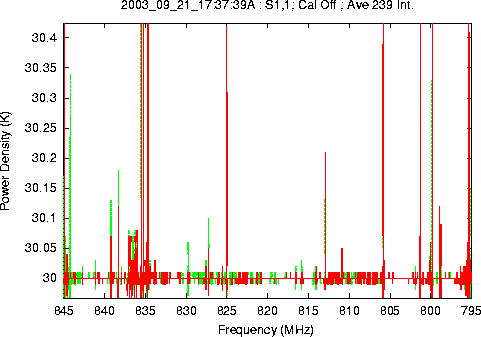
|
||||||||||||||||||||||||||||||||||||||||||||||||||||||||||||||||||||||||||||||||||||||||||||||||||||||||||||||||||||||||||||||||||||||||||||||||||||||||||||||||||||||||||||||||||||||||||||||
| Zoom in on the calibrated spectra showing a strong RFI feature and two associated RFI peaks offset by 78 kHz. A linear fit has been subtracted from this spectral region, and a Gaussian fit to the brightest peak. |
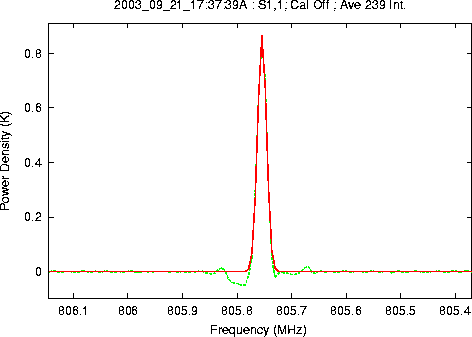
|
||||||||||||||||||||||||||||||||||||||||||||||||||||||||||||||||||||||||||||||||||||||||||||||||||||||||||||||||||||||||||||||||||||||||||||||||||||||||||||||||||||||||||||||||||||||||||||||
| Selected RFI features, after subtraction of a linear baseline. Ascii Data (2003_09_21_17:37:39A.3.log) |
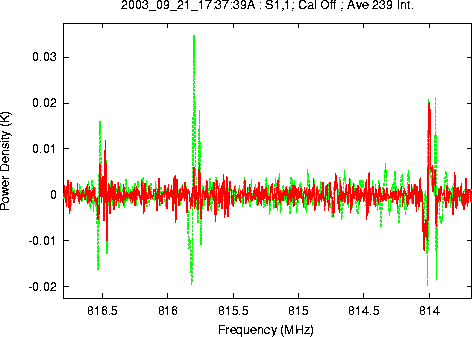
|
||||||||||||||||||||||||||||||||||||||||||||||||||||||||||||||||||||||||||||||||||||||||||||||||||||||||||||||||||||||||||||||||||||||||||||||||||||||||||||||||||||||||||||||||||||||||||||||
| Zoom in on the average uncalibrated spectrum, showing the communcations signal which dominates the spectral range 835.95 to 827.25 MHz. This signal is not always present. Fit:-11.938+/-0.159 Sl:0.014+/-0.000 Ascii Data (2003_09_21_17:37:39A.4.log) |
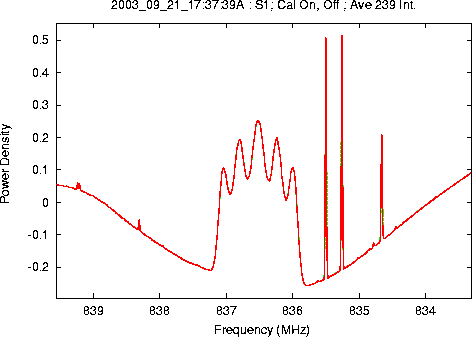
|
||||||||||||||||||||||||||||||||||||||||||||||||||||||||||||||||||||||||||||||||||||||||||||||||||||||||||||||||||||||||||||||||||||||||||||||||||||||||||||||||||||||||||||||||||||||||||||||
Observing Setup |
The data were taken in tandem with a BCPM pulsar observation by Ingrid Stairs. The observation used the GBT Prime Focus 1 receiver with the 800 MHz feed installed. The IF chain was configured for a dual circular polarization observation using optical driver modules 1 and 3 and converter rack modules 1 and 5. The LO1 sky frequency was 820 MHz and the convert rack lo2 frequency was 11155 MHz. The 50 MHz, dual polarziation, single quadrant mode of the spectrometer was used. A single two hour scan was performed, using 30 second integrations (a total of 239 integrations are in the output FITS file). During these observations no calibration signal injected into the IF path, so the intensity scale must be calibrated assuming an effective system temperature. For the spectra below, the intensity scale was set assuming a 30 K system temperature. The spectra have 8192 channels, corresponding to a spectral resolution of 6,104 Hz per channel. Since the observations were performed without injection of the noise diode signal, the normal calibration process could not be applied. Normally the Cal noise diode signal would be injected during a deep search for faint spectral features. The average of the cal signal over the observation would normaly be used to first correct for the system gain variations. In this case, the gain variations, would not contribute signficantly to the noise in the spectra. A more important limit on detecting faint features are the numerous weak RFI features. These must be detected by their intensity variations and excised before averaging. These data were obtained by Glen Langston for Ingrid Stairs using the GBT. The data were taken towards a pulsar, but no significant contribution is expected from the pulsar emission. Data were written to directory: |